BS ISO 12233:2017
BSI Standards Publication
Photography — Electronic still
picture imaging — Resolution
and spatial frequency
responses
�
BS ISO 12233:2017
BRITISH STANDARD
National foreword
This British Standard is the UK implementation of ISO 12233:2017.
It supersedes BS ISO 12233:2014 which is withdrawn.
The UK participation in its preparation was entrusted to Technical
Committee CPW/42, Photography.
A list of organizations represented on this committee can be
obtained on request to its secretary.
This publication does not purport to include all the necessary
provisions of a contract. Users are responsible for its correct
application.
© The British Standards Institution 2017.
Published by BSI Standards Limited 2017
ISBN 978 0 580 94951 7
ICS 37.040.10
Compliance with a British Standard cannot confer immunity from
legal obligations.
This British Standard was published under the authority of the
Standards Policy and Strategy Committee on 31 January 2017.
Amendments/corrigenda issued since publication
Date
Text affected
�
INTERNATIONAL
STANDARD
BS ISO 12233:2017
ISO
12233
Third edition
2017-01
Photography — Electronic still picture
imaging — Resolution and spatial
frequency responses
Photographie — Imagerie des prises de vues électroniques —
Résolution et réponses en fréquence spatiale
Reference number
ISO 12233:2017(E)
© ISO 2017
�
BS ISO 12233:2017
ISO 12233:2017(E)
COPYRIGHT PROTECTED DOCUMENT
© ISO 2017, Published in Switzerland
All rights reserved. Unless otherwise specified, no part of this publication may be reproduced or utilized otherwise in any form
or by any means, electronic or mechanical, including photocopying, or posting on the internet or an intranet, without prior
written permission. Permission can be requested from either ISO at the address below or ISO’s member body in the country of
the requester.
ISO copyright office
Ch. de Blandonnet 8 • CP 401
CH-1214 Vernier, Geneva, Switzerland
Tel. +41 22 749 01 11
Fax +41 22 749 09 47
copyright@iso.org
www.iso.org
ii
© ISO 2017 – All rights reserved
�
BS ISO 12233:2017
ISO 12233:2017(E)
5
6
7
8
1
2
3
4
Contents
Page
Foreword ..........................................................................................................................................................................................................................................v
Introduction ................................................................................................................................................................................................................................vi
Scope .................................................................................................................................................................................................................................1
Normative references ......................................................................................................................................................................................1
Terms and definitions .....................................................................................................................................................................................1
Test conditions .......................................................................................................................................................................................................5
Test chart illumination .....................................................................................................................................................................5
4.1
4.2
Camera framing and lens focal length setting ..............................................................................................................5
4.3
Camera focusing .....................................................................................................................................................................................6
4.4
Camera settings ......................................................................................................................................................................................6
4.5 White balance...........................................................................................................................................................................................6
4.6
Luminance and colour measurements ...............................................................................................................................6
4.7
Gamma correction ................................................................................................................................................................................6
Visual resolution measurement ...........................................................................................................................................................7
5.1
General ...........................................................................................................................................................................................................7
5.2
Test chart......................................................................................................................................................................................................7
5.2.1
General......................................................................................................................................................................................7
5.2.2 Material ....................................................................................................................................................................................7
5.2.3
Size ...............................................................................................................................................................................................7
5.2.4
Test patterns ........................................................................................................................................................................7
5.2.5
Test pattern modulation ............................................................................................................................................8
5.2.6
Positional tolerance .......................................................................................................................................................8
Rules of judgement for visual observation .....................................................................................................................8
5.3
5.3.1
Rules of judgement ........................................................................................................................................................8
5.3.2
An example of a correct visual judgement .................................................................................................9
Edge-based spatial frequency response (e-SFR) .................................................................................................................9
General ...........................................................................................................................................................................................................9
6.1
6.2 Methodology ..........................................................................................................................................................................................10
6.2.1
Selection of the edge region of interest (ROI) ......................................................................................10
Transformation into effective exposure ....................................................................................................10
6.2.2
6.2.3
Estimation of the location of the edge ........................................................................................................10
6.2.4
Formation of a super-sampled line spread function array .......................................................12
6.2.5
Computation of the e-SFR .....................................................................................................................................13
Sine-based spatial frequency response (s-SFR) measurement .........................................................................13
Presentation of results ................................................................................................................................................................................14
General ........................................................................................................................................................................................................14
8.1
Resolution ................................................................................................................................................................................................14
8.2
General...................................................................................................................................................................................14
8.2.1
8.2.2
Basic presentation .......................................................................................................................................................14
Representative presentation ..............................................................................................................................14
8.2.3
8.3
Spatial frequency response (SFR) .......................................................................................................................................15
8.3.1
General...................................................................................................................................................................................15
8.3.2
Spatial frequency response ..................................................................................................................................15
8.3.3
Report of resolution value derived from the s-SFR .........................................................................16
Annex A (informative) CIPA resolution test chart ................................................................................................................................17
Annex B (informative) Visual resolution measurement software ......................................................................................23
Annex C (informative) Low contrast edge SFR test chart with OECF patches ..........................................................28
Annex D (normative) Edge spatial frequency response (e-SFR) algorithm ..............................................................30
Annex E (normative) Sine wave star test chart .......................................................................................................................................33
iii
© ISO 2017 – All rights reserved
�
BS ISO 12233:2017
ISO 12233:2017(E)
Annex F (normative) Sine wave spatial frequency response (s-SFR) analysis algorithm ...........................35
Annex G (informative) Colour-filtered resolution measurements .....................................................................................39
Annex H (informative) Units and summary metrics .........................................................................................................................41
Annex I (informative) Original test chart defined in ISO 12233:2000 ...........................................................................44
Bibliography .............................................................................................................................................................................................................................48
iv
© ISO 2017 – All rights reserved
�
BS ISO 12233:2017
ISO 12233:2017(E)
Foreword
ISO (the International Organization for Standardization) is a worldwide federation of national standards
bodies (ISO member bodies). The work of preparing International Standards is normally carried out
through ISO technical committees. Each member body interested in a subject for which a technical
committee has been established has the right to be represented on that committee. International
organizations, governmental and non-governmental, in liaison with ISO, also take part in the work.
ISO collaborates closely with the International Electrotechnical Commission (IEC) on all matters of
electrotechnical standardization.
The procedures used to develop this document and those intended for its further maintenance are
described in the ISO/IEC Directives, Part 1. In particular the different approval criteria needed for the
different types of ISO documents should be noted. This document was drafted in accordance with the
editorial rules of the ISO/IEC Directives, Part 2 (see www .iso .org/ directives).
Attention is drawn to the possibility that some of the elements of this document may be the subject of
patent rights. ISO shall not be held responsible for identifying any or all such patent rights. Details of
any patent rights identified during the development of the document will be in the Introduction and/or
on the ISO list of patent declarations received (see www .iso .org/ patents).
Any trade name used in this document is information given for the convenience of users and does not
constitute an endorsement.
For an explanation on the meaning of ISO specific terms and expressions related to conformity assessment,
as well as information about ISO’s adherence to the World Trade Organization (WTO) principles in the
Technical Barriers to Trade (TBT) see the following URL: www .iso .org/ iso/ foreword .html.
The committee responsible for this document is ISO/TC 42, Photography.
This third edition cancels and replaces the second edition (ISO 12233:2014), of which it constitutes a
minor revision with changes in Annex D.
© ISO 2017 – All rights reserved
v
�
BS ISO 12233:2017
ISO 12233:2017(E)
Introduction
Purpose
Technical background
The spatial resolution capability is an important attribute of an electronic still-picture camera.
Resolution measurement standards allow users to compare and verify spatial resolution measurements.
This document defines terminology, test charts, and test methods for performing resolution
measurements for analogue and digital electronic still-picture cameras.
For consumer digital cameras, the term resolution is often incorrectly interpreted as the number of
addressable photoelements. While there are existing protocols for determining camera pixel counts,
these are not to be confused with the interpretation of resolution as addressed in this document.
Qualitatively, resolution is the ability of a camera to optically capture finely spaced detail, and is usually
reported as a single valued metric. Spatial frequency response (SFR) is a multi-valued metric that
measures contrast loss as a function of spatial frequency. Generally, contrast decreases as a function of
spatial frequency to a level where detail is no longer visually resolved. This limiting frequency value is
the resolution of the camera. A camera’s resolution and its SFR are determined by a number of factors.
These include, but are not limited to, the performance of the camera lens, the number of addressable
photoelements in the optical imaging device, and the electrical circuits in the camera, which can include
image compression and gamma correction functions.
While resolution and SFR are related metrics, their difference lies in their comprehensiveness and utility.
As articulated in this document, resolution is a single frequency parameter that indicates whether the
output signal contains a minimum threshold of detail information for visual detection. In other words,
resolution is the highest spatial frequency that a candidate camera can usefully capture under cited
conditions. It can be very valuable for rapid manufacturing testing, quality control monitoring, or for
providing a simple metric that can be easily understood by end users. The algorithm used to determine
resolution has been tested with visual experiments using human observers and correlates well with
their estimation of high frequency detail loss.
SFR is a numerical description of how contrast is changed by a camera as a function of the spatial
frequencies that describe the contrast. It is very beneficial for engineering, diagnostic, and image
evaluation purposes and serves as an umbrella function from which such metrics as sharpness and
acutance are derived. Often, practitioners will select the spatial frequency associated with a specified
SFR level as a modified non-visual resolution value.
In a departure from the first edition of this document, two SFR measurements are described.
Additionally, the first SFR metrology method, edge-based spatial frequency response, is identical to
that described in the first edition, except that a lower contrast edge is used for the test chart. Regions
of interest (ROI) near slanted vertical and horizontal edges are digitized and used to compute the SFR
levels. The use of a slanted edge allows the edge gradient to be measured at many phases relative to the
image sensor photoelements and to yield a phase-averaged SFR response.
A second sine wave-based SFR metrology technique is introduced in the second edition. Using a sine
wave modulated target in a polar format (e.g. Siemens star), it is intended to provide an SFR response
that is more resilient to ill-behaved spatial frequency signatures introduced by the image content driven
processing of consumer digital cameras. In this sense, it is intended to enable easier interpretation of
SFR levels from such camera sources. Comparing the results of the edge-based SFR and the sine-based
SFR might indicate the extent to which nonlinear processing is used.
The first step in determining visual resolution or SFR is to capture an image of a suitable test chart with
the camera under test. The test chart should include features of sufficiently fine detail and frequency
content such as edges, lines, square waves, or sine wave patterns. The test chart defined in this document
has been designed specifically to evaluate electronic still-picture cameras. It has not necessarily been
designed to evaluate other electronic imaging equipment such as input scanners, CRT displays, hard-
copy printers, or electro-photographic copiers, nor individual components of an electronic still-picture
camera, such as the lens.
vi
© ISO 2017 – All rights reserved
�

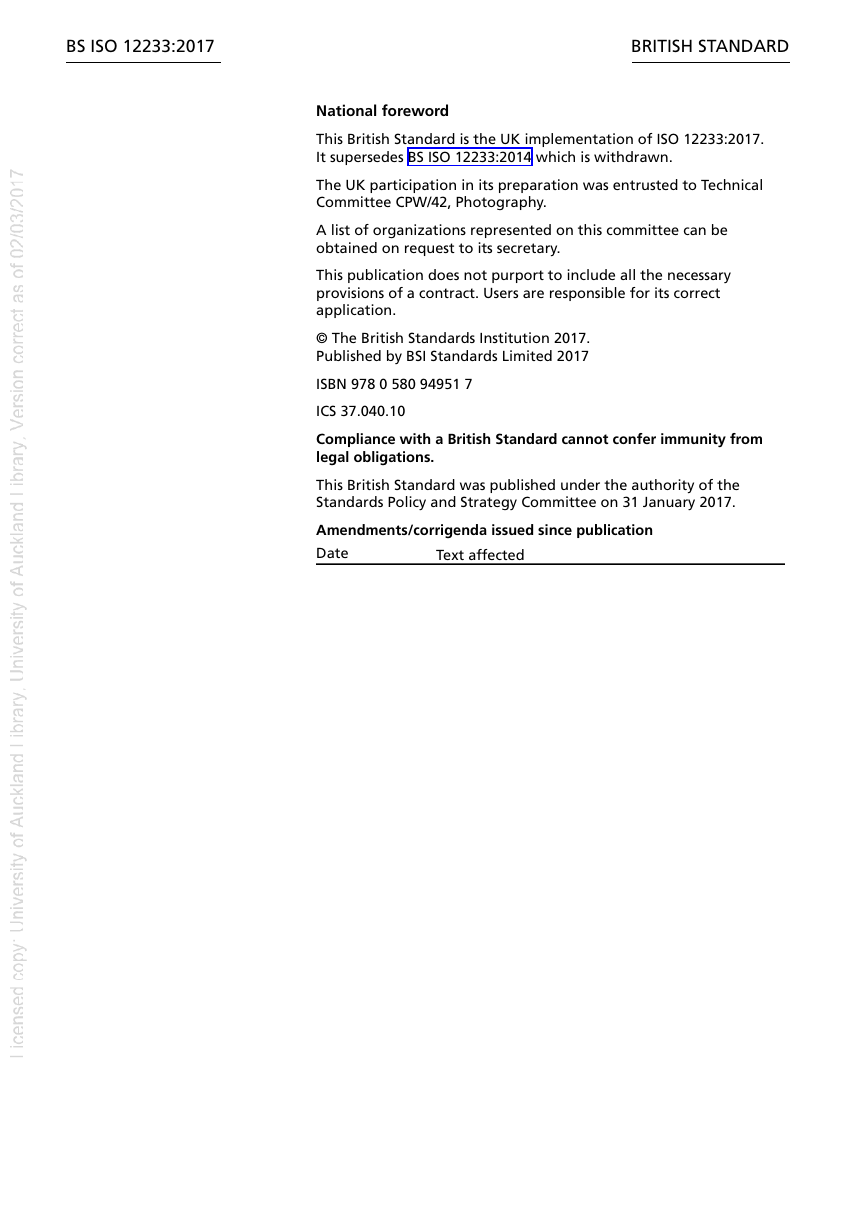
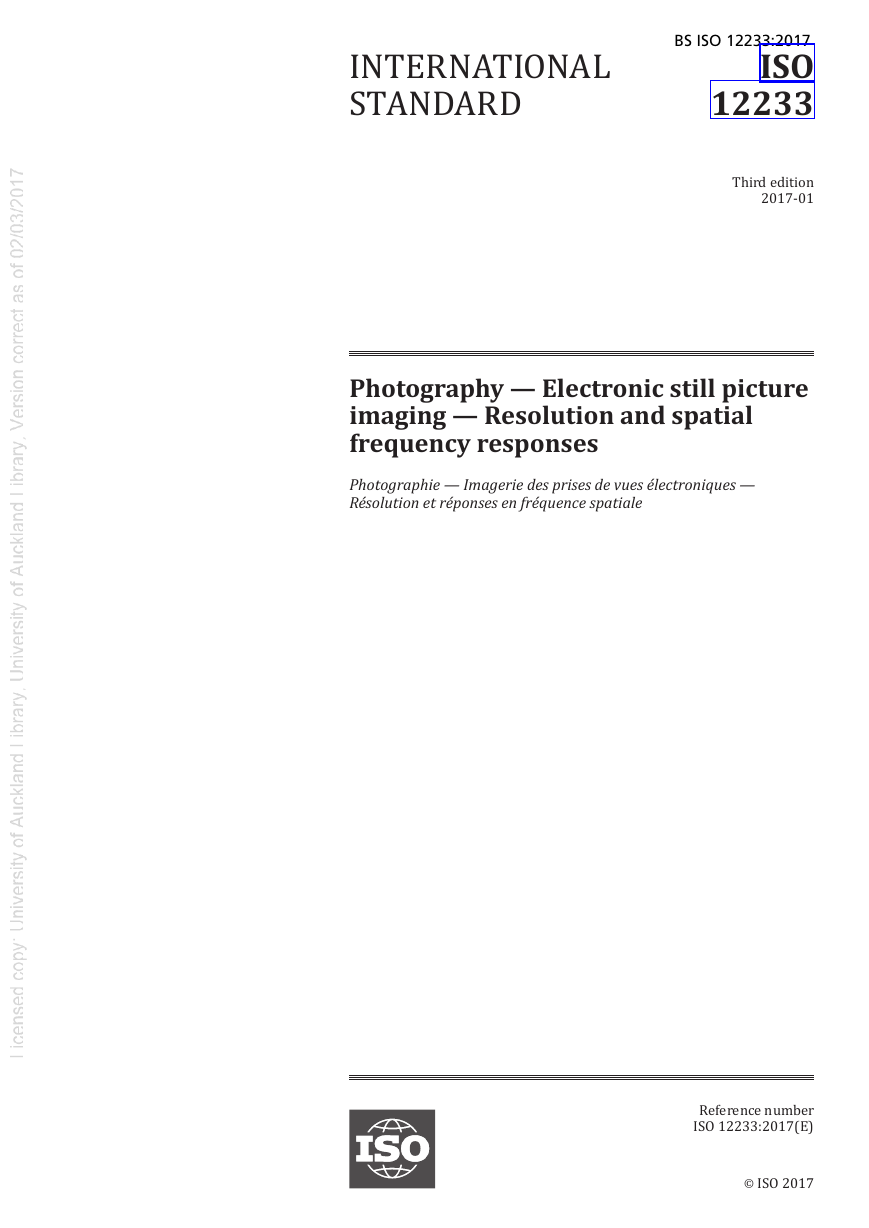
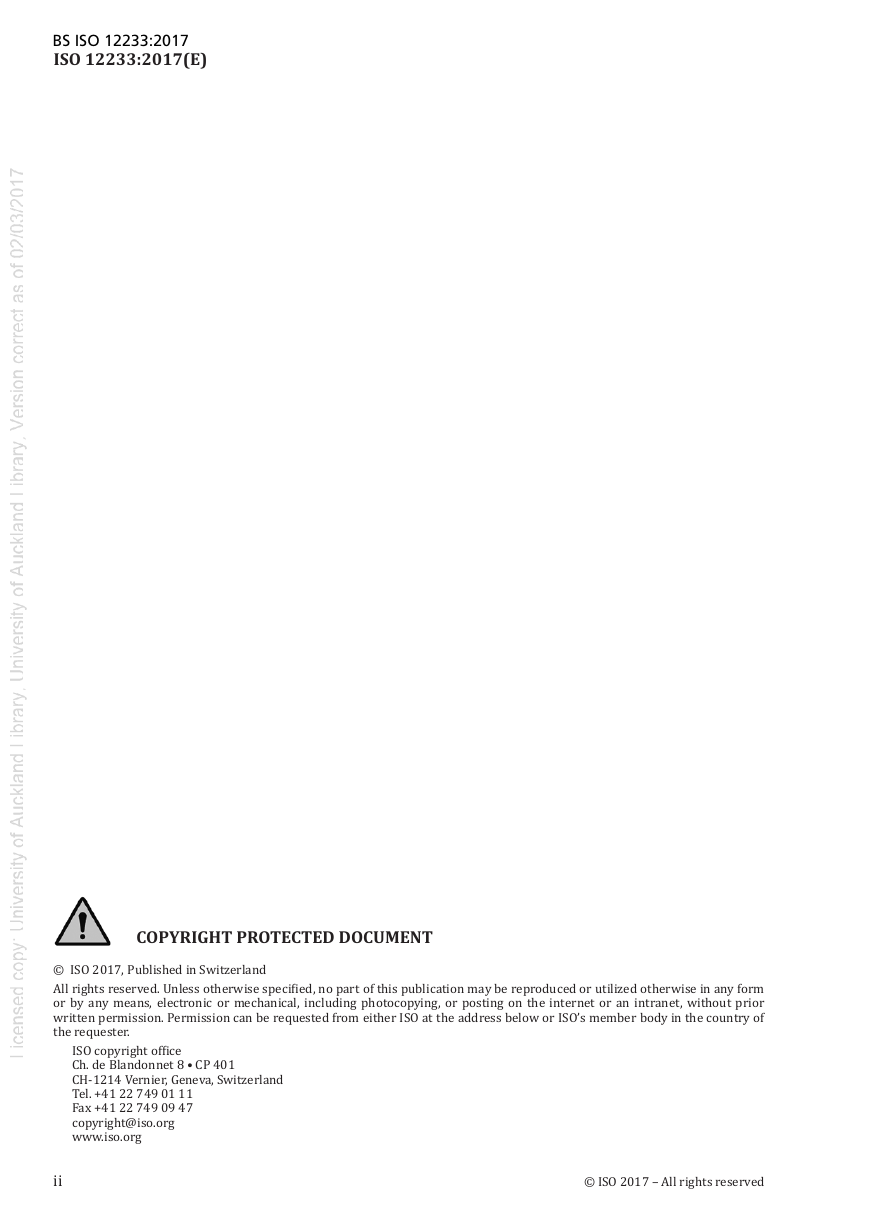
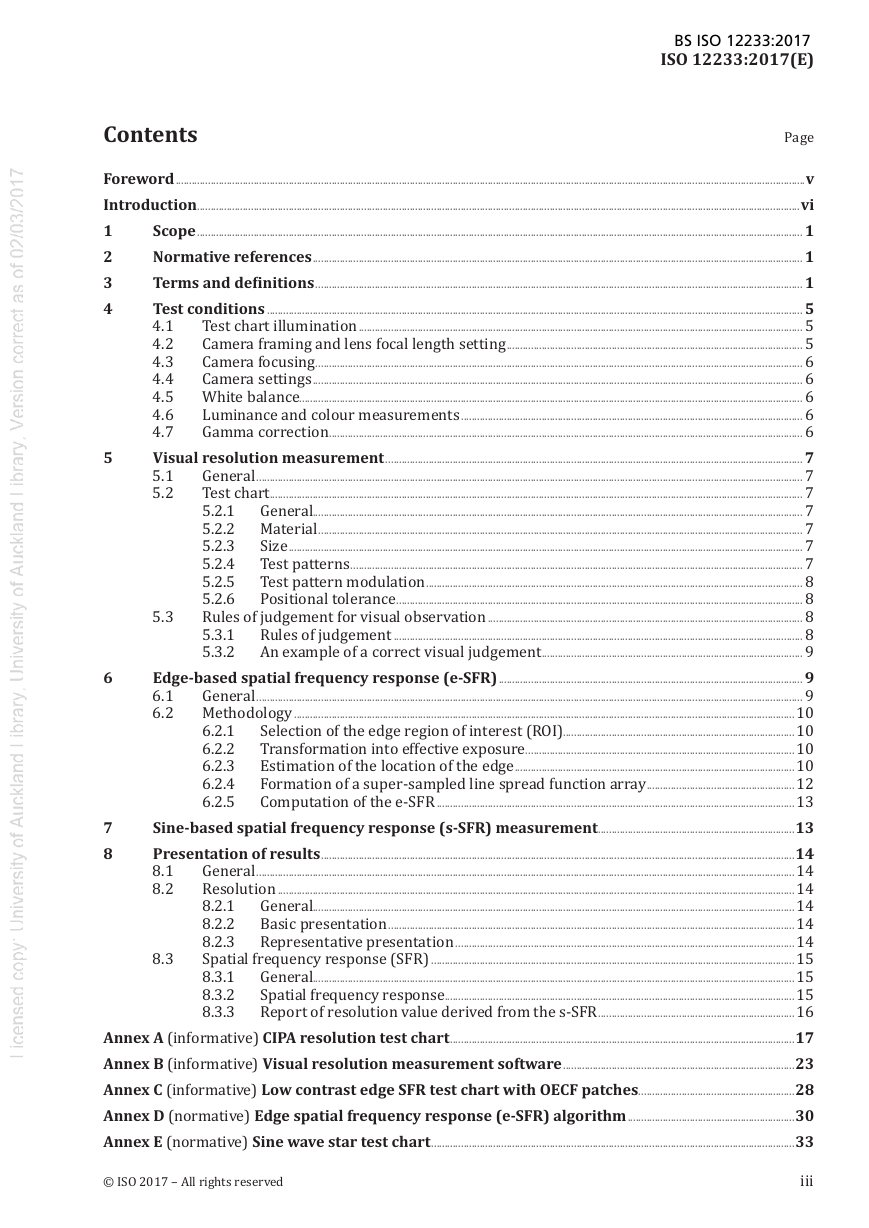


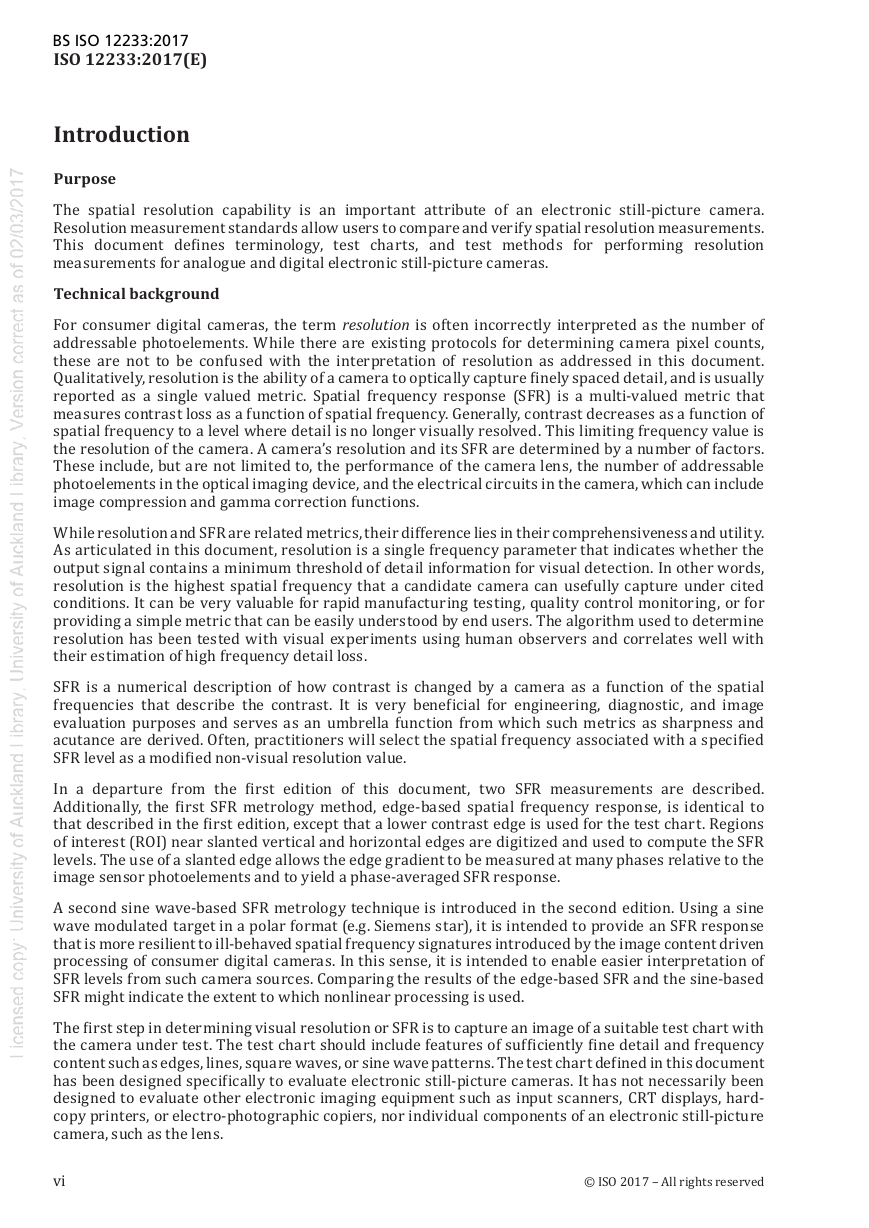








 2023年江西萍乡中考道德与法治真题及答案.doc
2023年江西萍乡中考道德与法治真题及答案.doc 2012年重庆南川中考生物真题及答案.doc
2012年重庆南川中考生物真题及答案.doc 2013年江西师范大学地理学综合及文艺理论基础考研真题.doc
2013年江西师范大学地理学综合及文艺理论基础考研真题.doc 2020年四川甘孜小升初语文真题及答案I卷.doc
2020年四川甘孜小升初语文真题及答案I卷.doc 2020年注册岩土工程师专业基础考试真题及答案.doc
2020年注册岩土工程师专业基础考试真题及答案.doc 2023-2024学年福建省厦门市九年级上学期数学月考试题及答案.doc
2023-2024学年福建省厦门市九年级上学期数学月考试题及答案.doc 2021-2022学年辽宁省沈阳市大东区九年级上学期语文期末试题及答案.doc
2021-2022学年辽宁省沈阳市大东区九年级上学期语文期末试题及答案.doc 2022-2023学年北京东城区初三第一学期物理期末试卷及答案.doc
2022-2023学年北京东城区初三第一学期物理期末试卷及答案.doc 2018上半年江西教师资格初中地理学科知识与教学能力真题及答案.doc
2018上半年江西教师资格初中地理学科知识与教学能力真题及答案.doc 2012年河北国家公务员申论考试真题及答案-省级.doc
2012年河北国家公务员申论考试真题及答案-省级.doc 2020-2021学年江苏省扬州市江都区邵樊片九年级上学期数学第一次质量检测试题及答案.doc
2020-2021学年江苏省扬州市江都区邵樊片九年级上学期数学第一次质量检测试题及答案.doc 2022下半年黑龙江教师资格证中学综合素质真题及答案.doc
2022下半年黑龙江教师资格证中学综合素质真题及答案.doc